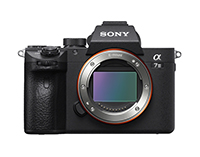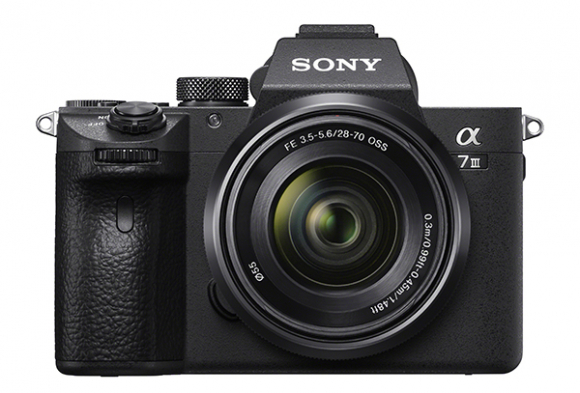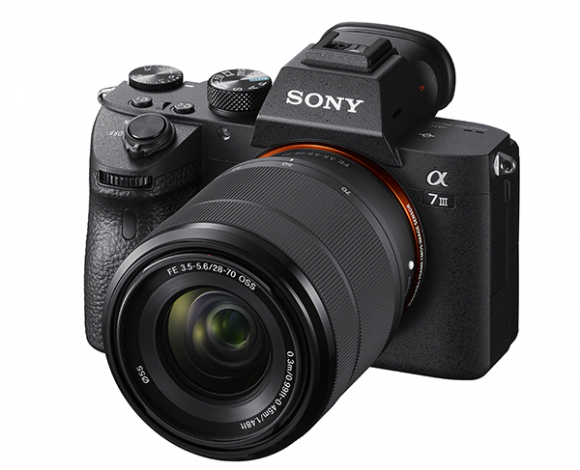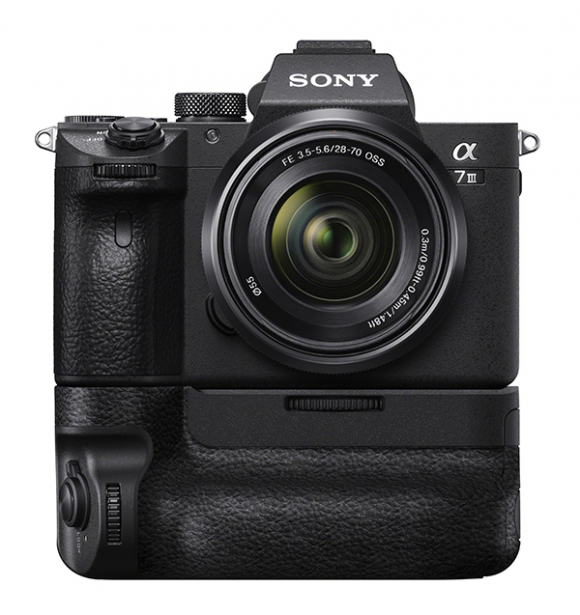Head-to-head: The Sony A7 III compared to its nearest rivals from Canon and Nikon. Which would you buy?
posted Tuesday, February 27, 2018 at 3:30 PM EDT

It’s getting kind of expected for Sony to announce totally amazing technology, so when they just announce something that’s really good but not extraordinary, it almost seems boring. At first glance, the Sony A7 Mark III might not seem all that exciting, but when compared against its closest competitors, you start to see how it fits into the market. One thing is for certain: Sony knew what they were doing announcing this during WPPI in Las Vegas.
Before I get into the comparisons, I wanted to first touch a bit on why launching this camera at WPPI makes so much sense. When we knew Sony was putting on this event, we sort of assumed it was going to be in tandem with a Japanese launch at CP+, the very large imaging trade show in Japan that is happening at almost the same time as WPPI this year. After seeing the camera though, I think Sony actually fully intended on launching it at and because of WPPI, despite this being perceived as a very low-end gear show, focused more on education and the business of portrait and wedding photography.
The Sony A7 III is a perfect wedding photographer’s camera.
With high ISO performance, image stabilization, middle-of-the-road resolution, and a very low price point (among a slew of other outstanding features that you’re probably used to seeing from Sony lately), this fits perfectly into the average wedding photographer’s “dream list” for a camera. I guarantee that at the show tomorrow, the A7 III is going to be one of the most popular stops for the WPPI convention-goers.
So with that said, the Sony A7 III is the camera from Sony that wedding photographers were really hoping for. Something with fewer megapixels than the A7R III that could shoot fast and handle the stress of an action-oriented shoot, but less expensive than the A9. Right now, the top cameras on the market that occupy this space are the D500, the D750, and the Canon 6D Mark II. Let’s see how they stack up against Sony’s latest.
[Ed. Note: This should not be read as our final verdict on the A7 III, by any means. That will have wait for our full review, as right now, we've yet to put the A7 III through our own comprehensive lab testing and so are reliant on Sony's own figures. Jaron's comparisons herein are based on a comparison of the cameras' specifications, plus a day or so of real-world experience with the A7 III, and his own experiences of the rival models. With that proviso out of the way, back to the article!]
Sensor/Performance Information
Sony A7 III: Full Frame, 24.2 megapixels, 15 stops of dynamic range, 10 frames per second with AF/AE (even for continuous and silent shooting), 14-bit raw. Buffer can handle 40 uncompressed raw images, 89 compressed raws or 163 Extra Fine JPEGs (manufacturer ratings, not yet lab-tested). Note that Sony does not offer lossless compressed raw.
Nikon D750: Full Frame, 24.3 megapixels, 14.5 stops of dynamic range, 6.5 frames per second, 14-bit raw. Buffer can handle 14 lossless compressed 14-bit raw, 22 lossless compressed 12-bit raws or 40 best-quality JPEGs. Note that we don't have a figure for uncompressed raws, as we don't typically test this if there's a lossless option.
Nikon D500: APS-C, 20.9 megapixels, 14 stops of dynamic range, 10 frames per second, 14-bit raw. Buffer can handle 200 lossless compressed raws or 200 best-quality JPEGs (up to the D500's max programmable burst limit). As with the D750, we don't have figures for uncompressed raws. And finally, we noted an occasional 0.5-second delay after around 50 frames when shooting lossless compressed raws, but other times the camera made it to 200 frames without a hiccup.
Canon 6D Mark II: Full Frame, 26.2 megapixels, ~12 stops of dynamic range, 6.5 frames per second, 14-bit lossless compressed raw. Buffer can handle 20 raw images or 98 best-quality JPEGs. The 6D II does not offer additional raw options such as uncompressed raw.

Winner: Sony A7 III
On the face of it, Sony’s A7 III has more dynamic range than all the cameras here and ties its nearest competitor for burst capture, where the D500 can also achieve the 10 frames per second. And outside of the D500 (which smokes the other three cameras in this category), the A7 III bests the rest for buffer depths as well. Bearing in mind that the D500 isn’t a full-frame camera and is equipped with the very fast XQD memory card, the A7 III losing to the Nikon here is somewhat more forgivable.
If the D500 was a full-frame camera, it would arguably be contending for the win here due mainly to that massive buffer capacity despite it being a couple stops short in the dynamic range category when compared to the A7 III. However, full-frame is important, and many wedding photographers are going to prioritize that over just about anything else due to better dynamic range and field of view. Those reasons, along with an affordable price point, are why the D750 is still a very popular wedding camera.
Looking at the full picture and with all other things being equal, the A7 III wins out here.
Autofocus
Sony A7 III: Uses 425 contrast autofocus points that work with a 693-point focal-plane phase-detection AF system. AF points occupy approximately 93% of the frame. Rated for EV -3 to 20. Sony also has Eye AF, which allows you to lock onto and follow a subject’s eye even with interrupting frames that may block view to the eye.
Nikon D750: Uses Nikon’s 51-point autofocus system with 15 points of the three center rows employing cross-type sensors , allowing focus detection on both vertical and horizontal axes. 11 points function to f/8, which will come in handy if you want to use a teleconverter. Rated for EV -3 to 19.
Nikon D500: Features 153 total phase-detection points, including 99 cross-type sensors for improved subject recognition, and 55 of the points are directly addressable, and the remainder aren't directly available to the photographer. 15 of the points (nine of them selectable) are compatible with an effective aperture of f/8, and all 153 points support working with effective apertures of f/5.6 or brighter. Rated for EV -4 to 20.
Canon 6D II: Incorporates an all-cross type AF system which offers 45 phase-detect points, for advanced tracking and focusing while using the optical finder for stills. This AF system will work with various lenses with maximum aperture of f/8 and smaller, though with a maximum of 27 points. Five different AF area selection modes are available as well, for optimizing performance to your subject matter. During live view and video shooting, employs the Dual Pixel sensor. Rated for EV -3 to 18.

Winner: Sony A7 III
Deciding which of these cameras has the best autofocus falls a bit more into preference and subjectivity than other camera features, but it’s hard to argue with the strengths of both the A7 III and the D500 over the other two cameras. The autofocus of the 6D II might be one of its more respected features, and the D750 isn’t aging well. The D500 has one of the best autofocus systems on the market, and the A7 III uses a system inherited from the exceptional A9 that in our testing is already showing that it’s got that proper lineage.
When compared directly to the D750 and 6D II, it's worth noting something about their types of face detection/eye detection features. The 6D II uses "Skin Tone" detection with 7.65K pixels. The D750 uses "Face" detection with 91K pixels. In the case of the 6D II, there isn't enough pixels there to pick out eyes, and in the case of the D750 there is enough to see the face but not really enough to see eyes. With the A7 III, the image sensor recognizes the eye and then Fast Hybrid AF focuses on the eye specifically. It's a vastly superior system for tracking a moving subject.
Overall both the D500 and the A7 III are really good, but the Sony just has more going on in more environments, although Nikon may just pip it for low-light AF.
Video Capabilities
Sony A7 III: Full-frame, oversampled 4K UHD at up to 24/30p, Hybrid Log Gamma, S-LOG1/2, slow-motion in Full HD 1080p up to 120 frames per second. Also includes video features like uncompressed HDMI output (8-bit 4:2:2), zebra striping and focus peaking.
Nikon D750: Full HD 1080p up to 24/25/30/50/60 frames per second. Uncompressed HDMI out at 4:2:2 8 bit.
Nikon D500: 4K UHD up to 24/25/30p and Full HD 1080p up to 60 frames per second. An approximate 1.5x crop factor in 4K on top of the APS-C sensor. 8-bit 4:2:2 uncompressed HDMI.
Canon 6D II: Full HD 1080p video up to 60 frames per second.
Winner: Sony A7 III
It’s actually not that close in the video department: The A7 III clearly wins out. It is the only camera here that offers 4K video using the full sensor with no crop factor, and it also offers the highest framerate in Full HD at 120p. It's also the only one with focus peaking or zebra striping, and also bests the 6D II with uncompressed HDMI output, as do the Nikons.
Other Notable factors
ISO Performance
Sony A7 III: Range of 100 - 51,200 (expandable to ISO 50 - 204,800 for still images)
Nikon D750: Range of 100 - 12,800 (expandable to ISO 50 - 51,200)
Nikon D500: Range 100 - 51,200 (expandable to 50 - 1,638,400)
Canon 6D II: Range of 100 - 40,000 (expandable to 50 - 102,400)
Image Stabilization
Sony A7 III: 5-axis on-sensor stabilization plus any lens stabilization
Nikon D750: None in body, relies on lens stabilization
Nikon D500: None in body, relies on lens stabilization
Canon 6D II: None in body, relies on lens stabilization
Maximum/Minimum Shutter Speeds
Sony A7 III: 1/8000 - 30 seconds
Nikon D750: 1/4000 - 30 seconds
Nikon D500: 1/8000 - 30 seconds
Canon 6D II: 1/4000 - 30 seconds
Weight, loaded but without lens
Sony A7 III: 22.9 ounces (650 grams)
Nikon D750: 29.7 ounces (840 grams)
Nikon D500: 30.4 ounces (860 grams)
Canon 6D II: 27.0 ounces (765 grams)
Memory Card Options
Sony A7 III: Two SD card slots, one UHS-II and both UHS-I.
Nikon D750: Two SD card slots, both UHS-I
Nikon D500: One XQD slot, one SD slot that supports UHS-II
Canon 6D II: One SD slot that supports UHS-I
Battery Life
Sony A7 III: 610 frames with EVF, 710 frames with LCD
Nikon D750: 1,230 frames with viewfinder, unstated with LCD
Nikon D500: 1,240 frames with viewfinder, unstated with LCD
Canon 6D II: 1,200 frames with viewfinder, 380 frames with LCD
Price Point (body only)
Sony A7 III: $2,000
Nikon D750: $1,800
Nikon D500: $1,900
Canon 6D II: $1,900

Conclusion
There is a lot to digest here, and some of it is going to fall into preferential subjectivity by users. High ISO performance is still being evaluated on the A7 III, but if it’s similar to the A9, we should expect printable usability at up to ISO 6400, and general online usability at up to ISO 12,800. It might be better, it might be worse. The D500 occupies similar territory, while the other two cameras are best not pushed beyond ISO 6400.
As far as in-body stabilization, some people like it, some demand it, others could do without it. If you like it, then the A7 III wins easily here as it’s the only camera on the list to offer it. If you don’t like it, your options open up.
Where the A7 III and D500 can both manage a swift 1/8000-second maximum shutter speed to help freeze fast-moving subjects, the 6D II and D750 are both capped at a maximum of 1/4000-second. Doubtless this saved a little cost -- and both cameras are a little more affordable than is the A7 III in particular -- but it's my opinion that no full frame camera should have a shutter speed capped at 1/4000 second.
As far as weight is concerned, we could have an argument about how things kind of stabilize once you get lenses involved, but from a pure “this is how much the body weighs” standpoint, the A7 III is much lighter than any of its rivals. The D500 in particular is getting on for 50% heavier.
In the memory card department, the A7 II comes in second to the outstanding D500, and that XQD card slot is a big part of why the D500 is capable of such an incredible buffer depth. The A7 II, like both the A9 and A7R III in this writer’s opinion, could have benefitted from two UHS-II slots, but the single slot is generally good enough in most users' cases.
As far as price point, though the A7 III is the most expensive, it’s only barely the most expensive. Its closest competitors are all within $200. It’s actually shocking how expensive the 6D II is, when you look at its specifications compared to the other three. It’s woefully less of a camera than even the D750, which is rather long in the tooth. As far as value goes, the A7 III is very well priced indeed.
One more thing to note is battery life. This used to be a big hitch for those thinking of moving to mirrorless, and honestly, it's still not yet up to DSLR levels -- but that's hardly surprising, as bouncing light off a mirror doesn't require any power consumption, but illuminating an electronic viewfinder takes plenty. The Sony A9 debuted a significantly improved battery that has since made its way to both the A7R III and the new A7 III, and while battery life thru the viewfinder certainly still trails DSLRs, honestly you're going to need to be doing a lot of shooting before you run up against a dead battery, even with the viewfinder. But if you are shooting that much, well... there's certainly still something to be said for the DSLR viewfinder in that respect.
The A7 III either outright wins in almost all of these categories, or it is tying with the APS-C D500. Don’t get me wrong, the D500 is a really excellent camera that I highly recommend, but the A7 III is doing almost the same exceptional things but in a smaller body with a full frame sensor. Especially in the video department, the A7 III is a cut above the D500 and absolutely slays the other two.
Overall Winner: Sony A7 III
Some of you may be wondering why I didn't include cameras like the 5D Mark IV or the Pentax K-1 Mark II in this comparison, and it’s because those cameras are in a different category, competing more with the A7R III. Could the A7 III be compared to them and do well? Absolutely, but the general specifications and feature list lines aren’t really in sync. Comparing them can devolve more readily into an “I prefer” rather than a specific feature list. If you are considering buying a 5D Mark IV, D850, or K-1 II but now are suddenly interested in the $2000 A7 III, I don’t blame you. There is a lot to love.
I do really want to emphasize how resolution does matter here. For event shooters, wedding photographers and many portrait photographers (think senior photos, newborn sessions or engagements), big megapixel ratings mean lots of hard drive space and slow processing. One of my close friends is a Getty photographer, and he lamented the D810's high resolution for years as it bogged down his computer and sucked up tons of hard drives. For a busy, active event photographer, you don’t want more megapixels. You want better, compact megapixels. The A7 III fits that bill nicely, as do the other three cameras on this list.
Hopefully by this point you’re seeing that the A7 III isn’t just a cheaper version of the A7R III with fewer features. It’s not supposed to be a “consolation” camera for those who can’t afford an A9 or A7R III. It’s designed specifically to target the wedding and portraiture market that relies heavily on full frame, moderate megapixels, high frames per second, and excellent auto focus. Given that this particular segment of the photo market is both the largest and the least served by the cameras available, the A7 III is aimed to do very well here.
So, wedding photographers, what do you think? Did Sony create a camera you want to buy, or are you going to give it a pass? Let us know in the comments below. Want to know more about the A7 III, and see our real-world sample photos? Hop on over to our in-progress Sony A7 III review now!